At the Feet of Whom?
 There has been a myriad of ideas on what to do with the overabundance of so-called “free time” during the stay-at-home orders issued by most states.
There has been a myriad of ideas on what to do with the overabundance of so-called “free time” during the stay-at-home orders issued by most states.
Certainly, one can follow the news about the Coronavirus Pandemic closely and follow the guidelines to keep ourselves and loved ones safe. But we also see many people who do not have the luxury of just staying home and waiting it out. They have to get up and go to work and interact with people, some of whom are very sick with the virus or other illnesses.
Some have to contend with people who are frightened or just downright rude. People who are nasty and rude are typically just struggling with fear and insecurity (something we can all relate to).
When we perceive that we are threatened in some way, we can lash out at others out of this fear and insecurity. Our culture and way of life in the USA has been turned upside down and our minds race with many “what ifs”. For example,
- What if it gets even worse?
- What if there is trouble with food supplies?
- What if someone near and dear to me is stricken with this virus and I cannot hold their hand, give them a hug, and comfort them.
I know I would be in a state of panic, yes fraught with fear and insecurity, if I couldn’t be with my Mom if she were ill and dying. I might even get nasty. Who knows and I do not want to find out.
In the last blog I wrote of finding a “routine” which has been comforting and quite frankly very productive. There also continues to be many things written and displayed on social media about how people are utilizing what I will call this “gift of time”.
Some of it is so beautiful, some “just okay”, and some not so much. What we are finding is that our “feet” can take us many places and for example, just taking a regular walk each day and seeing neighbors is quite refreshing. Simple conversation and friendship. And yes, we even horsed around with a couple of grandkids in their front yard while keeping proper social distancing of course! I also got a tremendous “kick out of it” yesterday when my lovely wife, Rita, did a session of “virtual” Jazzercise. She has got the moves and how fun is that.
There is a remarkable woman in the Bible named Mary Magdalen who is privileged to be the first one to see the Risen Christ. She discovers that the stone of Christ’s tomb has been rolled away and she goes and tells Peter and John to go see for themselves.
Now, I just want to hit the pause button here so that the reader is not “turned off” by a story about Christ and His Resurrection. Hang in there please, even if you do not believe or are just not sure. This is not an attempt to “force” you to believe. It is about one woman’s journey that all of us can profit from right now whether you “believe” or are just not sure. Stay with it.
Mary Magdalen by all accounts has encountered Christ on several occasions and we find her always at his “feet”. At Bethany, while Martha is bustling about preparing the meal, Mary sits at the feet of Jesus and listens to him. When she is at the house of Simon the Leper, the Saturday before the Passion, she breaks a vase of precious ointment and pours it over the feet of Jesus. She is literally bathing Christ’s feet with her tears and wiping his feet with her hair. Lastly, we meet her at the foot of the cross along with Mary, Jesus’ mother, and John the Evangelist. Mary is single-minded in her passion for the Lord and always at his feet.
This begs the question, whose feet are you sitting at these days?
There is an expression commonly known as the “Seat of Wisdom”. There is so much information and data, and yes, even those who display tremendous knowledge and even insight to the challenges ahead. But we need to seek a “Seat of Wisdom” and sit at the feet of people who are not only trustworthy but humble. They are quiet, serene and willing to listen very carefully to what you have to say.
Mary Magdalen was surrounded by much clamor and a culture probably not much different than ours. People looked to be entertained, sought pleasurable things, and wanted to be noticed. Power, honors, riches, comfort, and pleasure. We all have these desires. Mary Magdalen had them too but as time went on she “purified” her desires and began to deliberately sit at the feet of one who met all of these needs.
Vanity, comparing ourselves to others, or Pride, an overinflated sense of who you are, or Lust, an appetite for the pleasurable things of this world had come and gone for Mary as she passionately sought the one and highest good, God himself in the flesh.
Whose feet are you sitting at in this time of challenge and perhaps fear?
Anything can become an “idol” and waste “idle” time. Some would say pick up a Bible and read it. Good advice. What about sitting each day in silence with your thoughts and begin to sort them out. Identify the insecurities in your life. Examine your weaknesses (mine is very often patience!). Listen and quiet yourself. Feel it in your bones, a peace you cannot imagine.
So read this each morning and just sit with it…
*May today there be peace within.
*May you trust God that you are exactly where you are meant to be.
*May you not forget the infinite possibilities born of faith.
*May you use those gifts that you have received, and pass on the love that has been given to you.
*May you be content knowing that you are a Child of God.
*Let this presence settle into your bones, and allow your soul the freedom to sing, dance, praise, and love.
*It is there for each and every one of us.
– The Little Flower of Lisieux
Please, Stay at Home. And Yes, home is where the heart is.
No doubt many of us have been thrown for a loop with the spread of the Corona Virus or COVID 19. For many, our work life has been greatly altered. Ponder that Macy’s laid off most of their workforce (about 125,000 people) while the company was already in the midst of closing many stores permanently.
We can look at the reason for these events, but really, it’s better to look at the “here and now”. What is happening, and how can you cope? Tragedy seems literally a breath away.
 On April 15th, 2019 Notre Dame burned.
On April 15th, 2019 Notre Dame burned.
Here is a reflection from that event.
A Cathedral burns – and it wasn’t just any cathedral.
Imagine one of your most prized possessions, like your home, going up in smoke. Although you were able to save some special mementos, you are in shock as to how this could have happened. Notre Dame survived the Nazi occupation, Napoleon, and the Enlightenment, among many other threats. Then one day, during major renovations, it just catches fire and is nearly gutted. What can this possibly mean? Is it just an accident, a misjudgment on somebody’s part? How can this be?
Did people actually worship here or was it merely a tourist attraction – a place to tour as a historical site with a vague history, to most who walk in. Do they know that Christ is ever-present in the Eucharist in this Cathedral? Are they seeking him?
Do people actually go to Mass there and confession or is it just another stop on the Metro system or a pleasant walk over from some restaurant. “Hey, let’s go see Notre Dame, I hear it is beautiful inside!”
So, what is going on here? A picture shows the inside of the charred cathedral with a lone cross standing. What is God saying to us? Why just that cross, an icon, standing there as if it was staring at us?
Often in our daily prayers, we are prompted to consider what God might be saying to us through the events of the day. What were the significant moments of your day, and what could they possibly mean? What does this mean, that lone cross standing in the ruins of the cathedral?
My friends, an alarm has sounded and been going off for nearly a century. The bodies have piled up, society is grossly obscene, comfort reigns, and callousness knows no boundaries. Just think of human trafficking – I hope you are repulsed by the thought. But we insulate ourselves and try to enjoy life – not thinking about the ugliness that surrounds us. Few of us are seeking truth, goodness, or beauty. And then one day, a cathedral burns – a raging inferno – until a lone cross remains, standing in the charred ruins, before us. That cross calls to us, cries to us, and implores us to consider its meaning. Christ gives himself totally to us again and again, but we waffle – doing only what want we want to do. On we go to the next stop on the tour, the next adventure, the next . . . whatever. And Christ waits. He suffers, but we are comfortable with a lifestyle that says, “please do not disturb.”
Don’t kid yourself – what happened when Notre Dame burned was monumental. It was radical. Something is afoot. Our Lady had said to us – so many times over and over – pray, fast, go to confession, and pray some more. The Rosary! Humble yourself . . . be silent and listen. Keep persevering. See the cross of My Son, Jesus Christ Crucified!
I must confess that these last few weeks, starting on March 16, put me into a depression. I just felt frozen in my shoes, unable to do much of anything. Some of it came to light as selfishness. I was like a passive-aggressive child who wanted to do what I wanted to do, so it became a bit of a vacation. On to the next thing, the next adventure, the next . . . whatever. Oh yes, I have prayed more fervently and even managed to go to confession, but what has struck me most is something I read in a book, “The Confession”, by John Grisham. It has to do with Abandonment to Divine Providence.
In the book, a 19-year-old man named Donte Drumm is unjustly sentenced to death row. He comes from a loving, upright, God-fearing family, is a conscientious student/young man, and a great high school football player. How could this have happened? As a side note, John Grisham’s books are like listening to a great musical artist – natural, fluent, and resonant on many different levels. They show the beautiful and ugly sides to life in a very real way.
Anyway, our young man is further humiliated when he is placed in solitary confinement (something he didn’t deserve, for he is a model prisoner) in another facility and is in his cell now 23 hours per day with no TV. And he does despair. As if almost in shock and denial, he tries to sleep away the days and subsist on the meager food, somedays augmented by the five pieces of white bread that is necessary to get the prisoners their mandated daily 2,200 calories. After a time, he comes to his senses and develops something he labels “The Routine” – which is a completely new way of looking at the immense amount of time he has on his hands and how to deal with it. Sleeping, eating, and repeating that pattern all day long is just not working. He is not in reality.
Drumm begins a workout routine with a simple set of 20 push-ups. Then he adds sit-ups and running in place. His routine includes getting up at the same time each day (5:00 a.m.), working out for an hour in his cell. He adds a few steps to his routine – writing two letters each day, memorizing a verse or two from the Bible, increasing his exercise time, identifying and writing to new pen-pals, reading at least a book each day, and writing in a journal. Isolation was almost killing him, but reaching out to others gave him a completely new lookout on life. Yes, there are setbacks, but The Routine has helped him deal with the reality of his existence.
So what is it like for us – now that we are surrounded by materialism that can see outside our window but not enjoy? Entertainment has become only accessible through a screen. Family members are closer now than on any recent vacation – and none can get much time apart from another. What’s the message in all this? It’s maybe that what’s consumed us is secularism. A world not built on the foundation of God’s word and deed, but on living for ourselves, for our own amusements and diversions. I think this is true for even those of us who thought we had a pretty good relationship with God – but have come to understand that we didn’t. We have no routine, just the next stop along the way with whatever diversion might grab our attention. I was lukewarm, ready to be spit out. Instead of going from one distraction to another, I realize that I should be in the moment – God’s moment – and deal with it by abandoning myself to the moment. Like Donte Drumm, I need to see the possibilities around me and embrace them – even if that means suffering. “Oh no, you mean we can’t go eat at our favorite restaurant tonight?”
Often in recent years, I have been encouraged by others to develop a “plan of life”, or a routine that has little room for variation. That core of that plan needs to be earnest prayer and meditation. It also needs the study of things that matter and stick with you. The inspiration of Donte Drumm sticks with me.
What else should that life plan include? Generosity! Connect with people in a real way. Reach out to them. My sister told me that she is calling someone different each day just to catch up with them. And what else should be in the plan? Pass your love and energy on, by sharing it with others. Stop mulling about and do something that isn’t about yourself. This is a time for marriages to return to their core – a mutual gift of self to one another. For us to look out and see the pain and suffering of others, and then to help where we are able. To put aside childish pursuits, to put aside vanity, and to abandon our desires and to pursue the desires of someone other than ourselves.
Pilgrimage to Ireland
I had the incredible opportunity to spend a week touring and learning about the most prominent landmarks of Catholicism in Ireland with fellow pilgrims. We encountered many stories, lessons, and practices that are at the core of Catholic faith, and my hope is to share a few of my learnings below.
First Day: Tour of Dublin
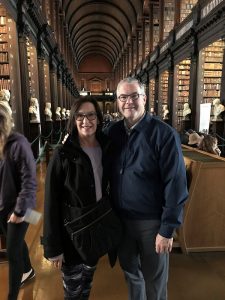
Trinity College with my wife Rita on our first day in Ireland.
Our first day was a long one due to travel from the U.S. We visited Trinity College where we saw the amazing “Book of Kells,” an illuminated manuscript Gospel book in Latin, containing the 4 Gospels of the New Testament: Matthew, Mark, Luke, and John.
It is a masterwork of Western calligraphy and represents the pinnacle of insular art, that is art produced in the post-Roman history of Ireland and Britain. These manuscripts were created around 800 A.D. and are on calfskin. You cannot take a picture of the originals, which are behind thick, dark glass.
After the viewing “The Book of Kells,” we saw the Long Room at Trinity College built between 1712 and 1732 and packed with over 200,000 books of the library’s oldest books. We saw a room which we could not photograph, where there were several people quietly restoring some of these books — certainly a room to visit for Harry Potter fans.
Lastly, a visit to St. Patrick’s Cathedral, the National Cathedral of the Church of Ireland since 1537, but founded in 1191-12 and dedicated to the St. Patrick, the great Catholic missionary and “Apostle of Ireland.”
Interesting fact: Christ Church Cathedral founded in 1030 A.D. is the seat for the Catholic Archbishop of Dublin. The most fascinating thing was hearing about Jonathan Swift. He was the “Dean” for St. Patrick’s from 1713 until his death in 1745. Swift is well-known for his book “Gulliver’s Travels” that he wrote in 1726. Besides being a great author, he was also known for his satire, poetry, and being a strong Irish patriot. Much of his writing reflects his political experiences. He also had a Doctor of Divinity degree and according to our guide could sermonize for as long as four hours.
Garden of Ireland and Glendalough
After a drive through the beautiful mountains of Wicklow, called the “Garden of Ireland,” we arrived in the ancient monastic city of Glendalough. Our guide, Stefan, explained why the street signs were in two languages, English and Gaelic, and the desire by the Irish to maintain a working knowledge of the Gaelic language. Glendalough was established in the sixth century by St. Kevin, and while there are many legends about St. Kevin, he is often compared to St. Francis of Assisi.
Later that day found us at a local restaurant and pub dedicated to many famous Irish literary figures including W. B. Yeats, one of the foremost literary figures in the 20th century. In front of his montage, I am hoisting a “Hop House Lager” beer. Yeats poem, “Long-Legged Fly,” is one of his greatest poems, and it is about silence and how the mind moves upon “silence.” It is about the role silence can play in the fostering of great minds around military tactics, beauty, and artistic creation.
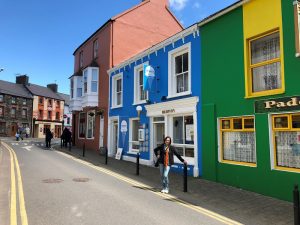
A typical Kilkenny street.
The picture to the left was taken on a typical street in Kilkenny. Because these homes are so uniform in appearance, the different colored doors allow for some distinction. This practice began in Dublin during the Georgian period from the early 18th to the early 19th century.
Interesting fact: In the far distance is the top of the cathedral, St. Canice, of the Church of Ireland built between 1202 and 1285. Catholic in origin, during the English Reformation, it was, by decree, handed over to the Church of Ireland in the late 16th century. There is a round tower from the ninth century that is still accessible by a steep set of internal ladders.
Pentecost Sunday at Rock of Cashel
Our third day fell on Pentecost Sunday. The bulk of the day was spent at the “Rock of Cashel” and ended with Mass at 5 p.m. at the Franciscan Friary in Killarney.
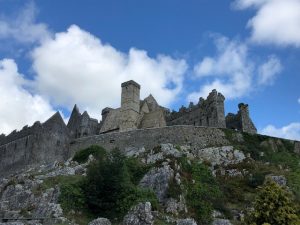
Rock of Cashel
The day finished with my second beer of the trip, a Smithwick’s Red Pale. Just a half pint and so far, of the two beers I have had, the best.
As for the “Rock of Cashel,” I had never heard of it, and quite frankly, we were blown away by what we saw. The religious buildings, dating from the 12th century, form the most spectacular set in Ireland. The site used to be the seat of the High Kings of Munster and is reputed to be the site of the conversion of the King of Munster to Christianity by St. Patrick in the fifth century. The King of Munster donated the site to the Church in 1101 AD. It is picturesque and has one of the most remarkable collections of Celtic art and medieval architecture in all of Europe.
The oldest and tallest of the buildings, the round tower, dates from 1100 A.D. and is 90 feet tall. There are 80 of these round towers in Ireland, and only 13 of them can be accessed. This one cannot. Our guide, David, was incredibly articulate about the history of the site.
Interesting fact: Cormac’s Chapel, the sandstone building, was begun in 1127 A.D. and finished in 1134. It is the very first Romanesque Church in Ireland. Over the years, the sandstone became waterlogged, and the interior frescoes were significantly damaged. A restoration project has completely rain-proofed the chapel, and there are interior dehumidifiers to dry out the stone.
The Cathedral was built between 1235 and 1270 and is an “aisle-less” building in the shape of a cross. In 1647, Cashel was “sacked” by the English, and the Catholic Clergy were all killed, as were the Irish Confederate troops. Among the clergy killed was Fr. Theobald Stapleton who in 1639, published a Catechism in Early Modern Irish to promote the use of the language in religious literature. It was the first noble attempt to simplify Irish spelling to encourage literacy among less educated people.
Dingle Peninsula and Gaelic

My third beer of the trip, a Guinness Stout.
We spent our fourth day in the County Kerry and on the Dingle Peninsula with spectacular views along the West Coast of Ireland. This area has the last part of the country that speaks the Gaelic language, and it is impossible to understand! In one village we visited today, BallyFerriter, about 75 percent of the town’s population speak the Gaelic, or Irish, language daily.
Peig Sayers: A Story of Inspiration
One of the truly inspirational people we heard about today was Peig Sayers who began her career at the age of 12 as a servant for a wealthy family. After a couple of years, she continued to work as a domestic servant for a growing middle-class family. Born in 1873, she was married at age 19 to a fisherman named Pádraig O Guithin and had 11 children of whom, six survived.
Besides being a housewife, she was a prolific author, storyteller, and historian. Though illiterate in the Gaelic language, she knew English, and she dictated her biography to her son Micheal. This bio was published in 1936, and soon after, she dictated 350 ancient legends, ghost stories, folk stories, and religious stories to the Irish Folklore Commission.
Peig Sayers is considered to be among the most famous of a late Gaelic revival genre of personal histories by and about the inhabitants of the Blasket Islands and other remote locations. She depicts the declining years of the traditional way of Gaelic speaking, the poverty that she knew personally, devout Catholicism, folk memories of gang violence, the Great Hunger (1845 to 1849), and the Penal Laws, which forced citizens to accept the Church of Ireland established by the English state Anglican Church.
A Day of Fun and Majesty
There is always a lot to be said about what we are seeing and hearing about in Ireland, but for today, there are only two things to reflect on: fun and majesty.
Joseph Mchugh’s
The fun began at lunch with the fourth beer of the trip, a Rockshore Irish Lager. There is now a tie with this beer and the Smithwick’s Red Ale. Though I only consumed half a pint, with a little help from Rita, it is easy to discriminate from the others. It does turn out that Smithwick’s brewery, founded in Kilkenny in 1710 by John Smithwick, is the most consumed ale in Ireland. The Smithwick family owned the business for 255 years. The brewery was acquired by Guinness in 1965, and The Rockshore was launched in February 2018.
We ate lunch at Joseph McHugh’s, and if you look closely over my left shoulder, you can see a picture of Joe on the wall. Here some lines from a poem about Joseph McHugh himself:
“Come all ye young fellahs, who travel the land,
In search of the crack, with guitar in your hand,
Go down to Liscannor, in the County of Clare,
You’ll find a pub in it that’s ever so rare.
Go into McHugh’s shop, the centre of town; You’ll get a warm welcome from Joe, Chalk it down,
The one-legged canary, will sing How Do You Do,
In the seven-day license of Joseph McHugh.”
Written by Dermott Kelly
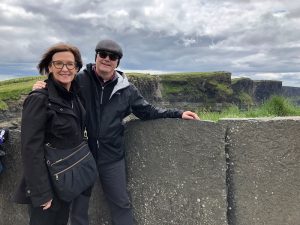
Rita and I in front of the Cliffs of Moher.
Cliffs of Moher
As for majesty, the Cliffs of Moher are simply that, majestic. They run for about 14 kilometers and at their southern end they rise about 390 feet above the Atlantic Ocean at a place referred to as Hag’s Head and reach their maximum height of 702 feet just past O’Brien’s Tower. The Cliffs of Moher rank among the most visited tourist spots in Ireland with 1.5 million visitors per year. At peak season, there are an estimated 30,000 pairs of birds living on the cliffs, representing more than 20 species. These include the Atlantic Puffins, the only puffin native to the Atlantic Ocean.
Feast Day of St. Barnabas
Happy Feast Day of St. Barnabas, the “son of encouragement and consolation.”
We started the day off with a visit to Clonmacnoise, considered to be Ireland’s most important monastic site founded by St. Ciaran in the sixth century. It was cold and wet, and the first inclement weather we have encountered that limited our desire to be “out and about.”
Interesting fact: The monastery is on the Shannon River in County Offlay, and it is a beautiful location that became a major center of religion, learning, craftsmanship, and trade by the ninth century. In 1552, the English destroyed and looted Clonmacnoise, leaving it in ruins. One of the first stops by St. John Paul II during his visit to Ireland in 1979 was to the monastery ruins.
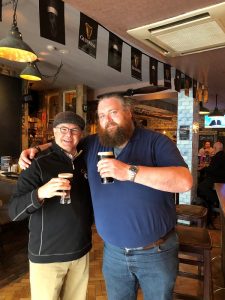
Patrick and I enjoying a White Gypsy Ruby Irish Red Ale.
My fifth beer of the trip was a recommendation from a gentleman by the name of Patrick that we met during lunch. It was an Irish Red Ale called White Gypsy Ruby. I rate it as one of the best I have had so far. I mentioned to Patrick that he was more than big enough to be an NFL football player, and he said he was well off, but thanks anyway!
After lunch, we took a cruise on Corrib Lake, which is the largest lake within the Republic of Ireland and the second largest on the Island of Ireland. It was a great way to see Galway and its surroundings.
We enjoyed dinner and another beer with one of our fellow pilgrims. This time a half pint of Heineken. Jim is an engineer, and his wife is a doctor. They live in Houston, TX, but are originally from Boston. Needless to say, they were rooting for the Boston Bruins in game seven of the Stanley Cup. Did I say Let’s Go Blues!
We visited Galway Cathedral before Mass at St. Mary’s, a Dominican parish. The full name of the Cathedral is the “Cathedral of Our Lady Assumed into Heaven and St. Nicholas. It was completed in 1965 and was built on the site of an old prison.
Since we were on a pilgrimage, I thought I would close by sharing some wisdom gleaned from some reading.
Jesus accepted the reality of human limits out of love for us and obedience to His Father. It only makes sense for us to do the same. “Therefore, I am content with weakness, insults, hardships, persecutions, and constraints, for the sake of Christ; for when I am weak, then I am strong.” 2 Corinthians 12:10.
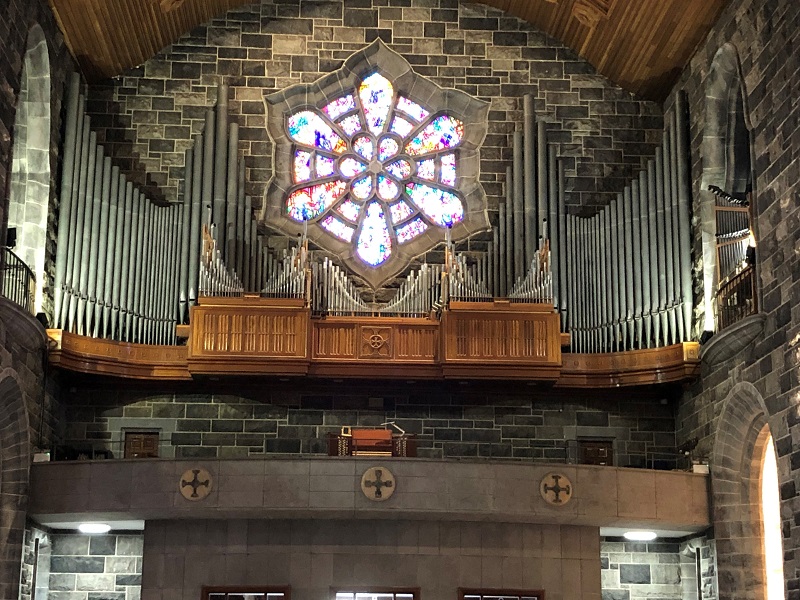
Galway Cathedral
Lamar Hunt Jr. purchases Topeka RoadRunners
Lamar Hunt Jr. wants to create a “hockey ecosystem” here in the Midwest, adding Topeka to his plans.
Lamar Hunt Jr. announced Wednesday that his company, Loretto Sports Ventures, purchased the Topeka RoadRunners from Don Stone, who had owned Topeka’s Tier II junior hockey team since 2009.
Hunt’s company also owns the Kansas City Mavericks, a professional hockey team, and his acquisition of the Topeka RoadRunners is part of a much broader plan to enhance the Midwest’s hockey game. Read more here…